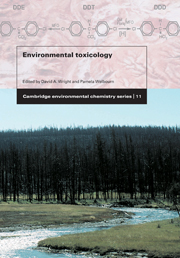Book contents
- Frontmatter
- Contents
- Foreword
- Preface
- Abbreviations
- Acknowledgements
- 1 The emergence of environmental toxicology as science
- 2 The science of environmental toxicology: Concepts and definitions
- 3 Routes and kinetics of toxicant uptake
- 4 Methodological approaches
- 5 Factors affecting toxicity
- 6 Metals and other inorganic chemicals
- 7 Organic compounds
- 8 Ionising radiation
- 9 Complex issues
- 10 Risk assessment
- 11 Recovery, rehabilitation, and reclamation
- 12 Regulatory toxicology
- 13 An overall perspective, or where to from here?
- Glossary
- Index
1 - The emergence of environmental toxicology as science
Published online by Cambridge University Press: 05 June 2012
- Frontmatter
- Contents
- Foreword
- Preface
- Abbreviations
- Acknowledgements
- 1 The emergence of environmental toxicology as science
- 2 The science of environmental toxicology: Concepts and definitions
- 3 Routes and kinetics of toxicant uptake
- 4 Methodological approaches
- 5 Factors affecting toxicity
- 6 Metals and other inorganic chemicals
- 7 Organic compounds
- 8 Ionising radiation
- 9 Complex issues
- 10 Risk assessment
- 11 Recovery, rehabilitation, and reclamation
- 12 Regulatory toxicology
- 13 An overall perspective, or where to from here?
- Glossary
- Index
Summary
The context
This textbook is predominantly about the science, that is to say the observable, verifiable science, of environmental toxicology. The introductory quotation from Lord Kelvin emphasises the need for quantification in scientific studies. But studies of the development of most branches of science reveal linkages among intellectual curiosity, technological advances, and an awareness of human-related problems, usually of social or of economic importance. Philosophically, it can be argued that quantification is not in itself sufficient to define and describe many environmental problems. The rich fabric of ideas, ideology, and technology that has led up to the current scientific discipline of environmental toxicology has been described and discussed by many authors in a variety of disciplines. Lord Ashby, referring in 1978 to protection of the environment, has aptly referred to the “quickening of the public conscience in most industrial countries” over the preceding 10 years. In the same series of essays, Ashby made a strong case for the position that values intrinsic to the environment cannot reasonably be measured, particularly in the context of monetary values. The quotation from Wilde, also quoted at the beginning of this book, although not made in the context of environment, captures this concept.
Environmental toxicology is only one component of the broader set of topics frequently referred to as environmental science and environmental studies. Other important aspects of environmental science are conservation of species, habitats and ecosystems, protection of endangered species, and various levels of management for water, soil, wildlife, and fisheries.
- Type
- Chapter
- Information
- Environmental Toxicology , pp. 1 - 20Publisher: Cambridge University PressPrint publication year: 2002



